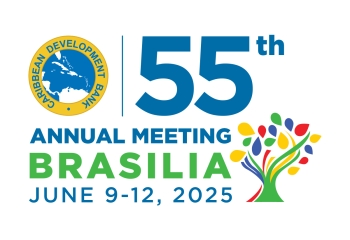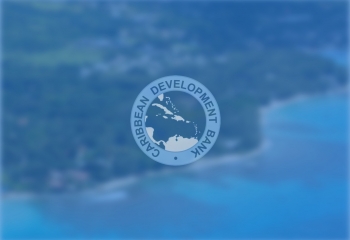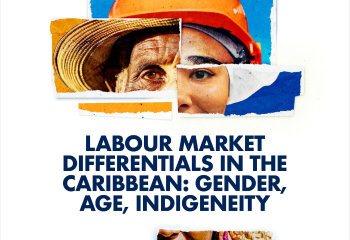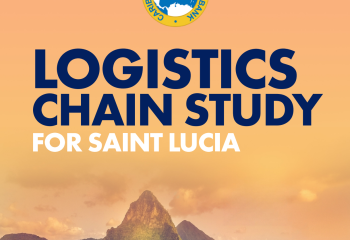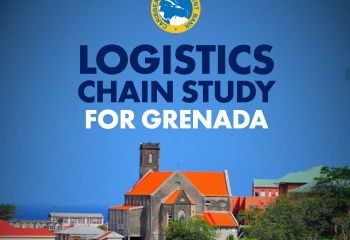Transcript- Transforming to a Digital Society
Trinidad and Tobago
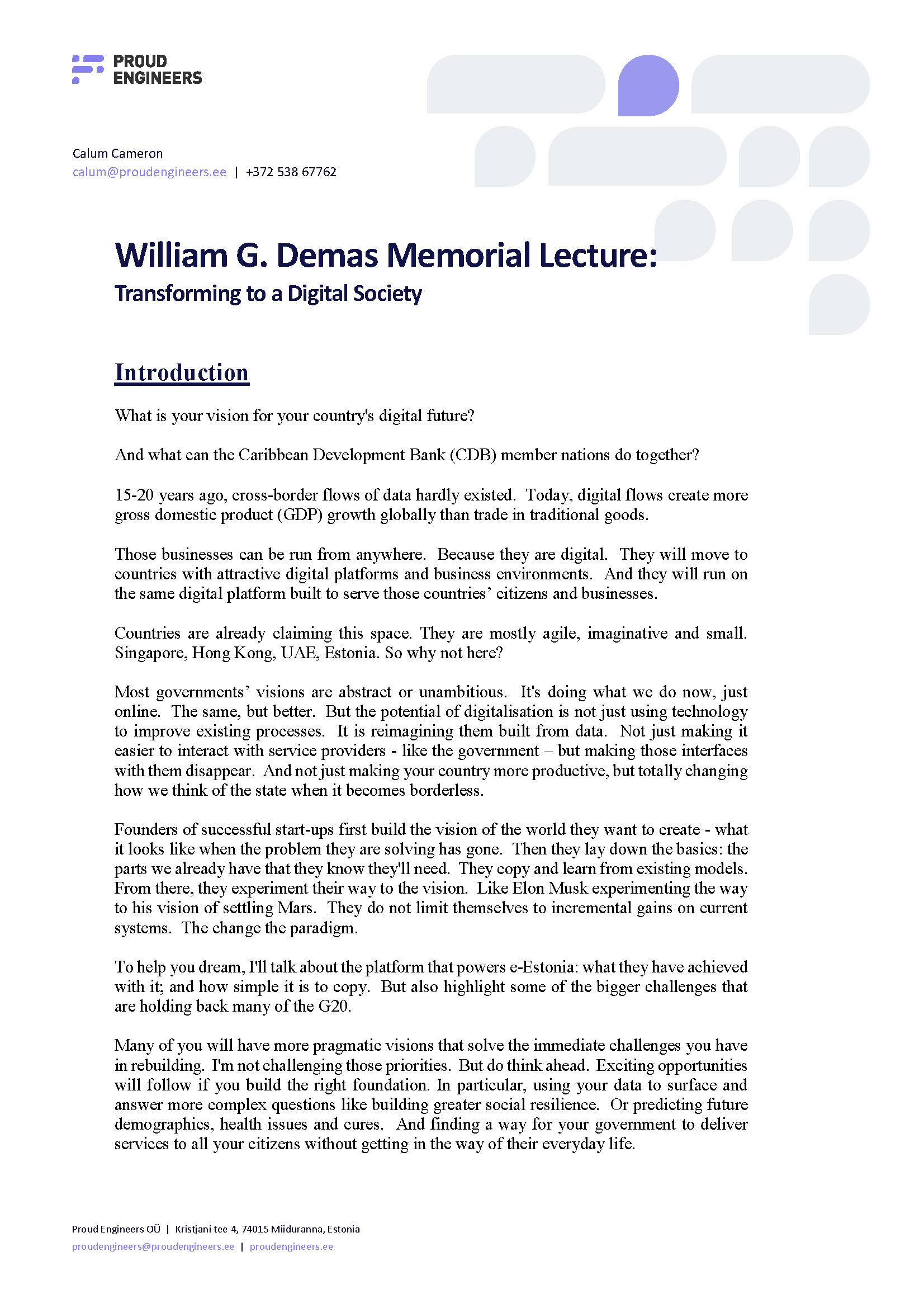
Introduction
What is your vision for your country's digital future?
And what can the Caribbean Development Bank (CDB) member nations do together?
15-20 years ago, cross-border flows of data hardly existed. Today, digital flows create more gross domestic product (GDP) growth globally than trade in traditional goods.
Those businesses can be run from anywhere. Because they are digital. They will move to countries with attractive digital platforms and business environments. And they will run on the same digital platform built to serve those countries’ citizens and businesses.
Countries are already claiming this space. They are mostly agile, imaginative and small. Singapore, Hong Kong, UAE, Estonia. So why not here?
Most governments’ visions are abstract or unambitious. It's doing what we do now, just online. The same, but better. But the potential of digitalisation is not just using technology to improve existing processes. It is reimagining them built from data. Not just making it easier to interact with service providers - like the government – but making those interfaces with them disappear. And not just making your country more productive, but totally changing how we think of the state when it becomes borderless.
Founders of successful start-ups first build the vision of the world they want to create - what it looks like when the problem they are solving has gone. Then they lay down the basics: the parts we already have that they know they'll need. They copy and learn from existing models. From there, they experiment their way to the vision. Like Elon Musk experimenting the way to his vision of settling Mars. They do not limit themselves to incremental gains on current systems. The change the paradigm.
To help you dream, I'll talk about the platform that powers e-Estonia: what they have achieved with it; and how simple it is to copy. But also highlight some of the bigger challenges that are holding back many of the G20.
Many of you will have more pragmatic visions that solve the immediate challenges you have in rebuilding. I'm not challenging those priorities. But do think ahead. Exciting opportunities will follow if you build the right foundation. In particular, using your data to surface and answer more complex questions like building greater social resilience. Or predicting future demographics, health issues and cures. And finding a way for your government to deliver services to all your citizens without getting in the way of their everyday life.
Estonia
That's Estonia's current priority. These people are seriously hard to please! They already have the world's most digitally integrated society. But it's not enough that 99% of public services are online. They want the government, or actually any bureaucracy, out of their lives.
Estonians believe that if a person is entitled to something, it should just happen. Automatically. Like child support benefits.
When my daughter was born, the mid-wife registered her online and immediately the child support benefits were paid into her mother’s bank account. You should understand, with their small population - the same as Trinidad and Tobago but ten-times the land mass - in Estonia, babies are national treasures. So anything that encourages new babies is top priority.
But the people aren't satisfied. They want a “seamless” digital society. Remove unnecessary distractions. OK the Tax and Customs board automatically prepares my tax return for me. But I waste 3 minutes logging into their platform to digitally sign and submit it. Every year!
1st world problems? But do think about these things already. Because, extending Professor Pelling's theme from last year, you have an opportunity to do much more than build back your old systems better. But rather to build to the digital paradigm. But you need to have a vision for it.
So what is it?
Because we know the platform. It is pretty straight forward for small, agile nations. But genuinely transforming is hard for more complacent societies, like Australia, UK, Germany, the US; even when their leaders recognise the need. Post-disaster recovery is an opportunity to leap past these 'developed' nations and build a platform to outplay them in the future.
That's what Estonia did.
Estonia's model was built from nothing: there was no model for them to copy. And they had no money. They had some clever people; and an ambition to return to Scandinavian living standards. They visited Sweden, Germany, Finland and decided this is what Estonia should look like. But they couldn't afford it. They didn't even have enough people to build such a civil service! So even though no country had done it before, they decided to achieve the same living standards, but built on IT.
So the model is pretty simple. It gives them home-ground advantage when competing in the digital world. While Australia and others are so busy struggling with cultural challenges they can't even bat their full eleven.
Estonia as a model
First a brief introduction to Estonia for those who haven't heard the story.
Estonia is a country of 1.3m people in the icy wastes of Viking Europe. It is way up North facing Sweden and Finland across the Baltic Sea and bordering Russia to the east.
During the Viking times, Estonians made a bit of a nuisance of themselves. So much so that eventually Sweden had to move its capital away from the coast and away from attacks by the Estonian Vikings.
What goes around, comes around. For most of the last millennium, Estonia was occupied. First the Danes, then the Swedes. Poles, Germans and Russians took their turns. Estonia was an independent Republic for only 38 years of the last millennium. The current Republic is only 28 years old. It seems unlikely the borders will not be tested again.
The Soviet occupation was more of a slow-motion hurricane. When it hit, Estonians were enjoying the same standard of living as their Scandinavian neighbours. Or even higher.
50 years later, they were one of the poorest countries in Europe, with a devastated economy and infrastructure that was being sold off as scrap metal.
Following re-independence in 1991, Estonia embarked on engineering the world’s first digital state. Starting from nothing was an advantage. No Victorian plumbing in the government, no bureaucratic labyrinth. They could build from scratch. Their significant decision was to place innovation and IT at the centre of building the nation. Even at a time when half of their people didn't even have a phone connection.
Now:
- 99% of all public services are online: available 24/7. Over 600 e-services to its citizens and 2,400 to businesses.
- 99% of medical prescriptions are digital.
- 98% of companies established online.
- 98% tax declarations done online.
- Over 40% of votes in recent national elections were electronic, creating a cumulative saving of over 11,000 working days nationwide.
- In the EU parliamentary elections two weeks ago 47% of Estonian votes were electronic. Making it the most popular way of voting for the first time.
Estonia estimates citizens save an average of over one weeks’ time each year by using digital authentication and e-signing solutions. That's around 2% of GDP. But I think it's more than that. Because when you remove the drag that bureaucracy and hassle create, people start to play more. They become more creative because their energy isn't being drained by pointless activities. Maybe that's why Estonia is also such a success story in the start-up world.
So as well as being small and agile, but with limited resources, this challenge of building a resilient state despite threats to its borders is something Estonia held in common with many Caribbean nations rebuilding now, with the long-term threat of extreme weather events.
So I think their model is worth looking at. Not to build like-for-like - tech in particular is always moving on - but to adopt the principles that Estonia has learnt the hard way.
Platform
The Estonian digital platform has some simple building blocks. They didn't know these back in the 90's, they had to experiment and discover them. You can skip their mistakes and build much faster.
Access
The first is obviously access. Your citizens need to connect. In 1996, already a programme was launched in Estonia to connect all schools to the Internet. In 2000, Internet access became a social right. Telecommunication providers were required to provide internet access to all parts of Estonia at the same price and quality. 100% of the country has had highspeed broadband internet access for a while now. By next year the minimum speed across the country will be 30 mbps. Most urban areas have much higher already.
Data
Digital society runs on data. The more data, and the better the quality, the more you can dream of doing. It starts from the citizen.
Population Register
The cornerstone of your platform is the Population Register. This is your digital register of every citizen and resident. It has all the usual basic info about your address, life events (births, deaths etc.), citizenship. It is the single source of truth in the state for this information.
The register simplifies functions that depend on accurate identity and address details: like child benefits; online voting; or running a census.
Australia’s 2016 census (choice of web form or paper) cost around USD350m (not including time lost by citizen’s that could have been doing something more productive) and took seven months to publish the initial results. A record. Because of the cost and complexity, they do this only every five years.
Estonia’s census is a database query that takes a few seconds to run. Reports can be updated in real-time. This is possible because Estonia’s Population Register contains a national identity number for everyone registered.
This is the primary key for the digital platform. It connects all their data across the government databases. For example, when the Roads Administration need my address to renew my driver's licence, they use that number to get my address from the Population Register. I don’t have to supply the address. I don’t have to supply documents to prove it. They don’t have the hassle of validating it.
The national identity number is issued at birth or when you register as a foreign resident and never changes.
Data interoperability
Data must be able to move securely and reliably between agencies to deliver services without requiring citizens to provide their data again and again to each agency. When the repositories are connected, you can start automating services. Because you don’t depend on citizens to transfer their data between the agencies. And you can anticipate needs and automate service delivery based on life events like giving birth.
When a mother in Estonia gives birth, the Ministry of Social Affairs knows it will be paying child support benefits to her. So when the mid-wife registers the birth in the Population Register, an event is triggered in Ministry of Social Affairs to pay benefits. To calculate how much, the mother's salary and tax data are pulled from Tax and Customs. Then the Ministry of Social Affairs then starts paying benefits to her bank account. It is all machine-to-machine and automatic.
Why waste everyone's time asking for answers you already know?
Australia, for comparison, has also digitalised this process. But they don't have a national ID, so they are limited to taking what they did offline, and putting it online. As a new parent, to get child support benefits, you have to apply for them:
- You log into the Department of Human Services website;
- Then complete an online questionnaire with answers the government already knows;
- And submit documents generated by other government agencies;
- You then submit a few more documents - also generally provided by government agencies - proving who you are;
- Then you can register, and prove with more documents, the child’s birth; and
- Payments start around two weeks later.
Why waste time asking for answers you already know?
But if they can, agencies will build data siloes. They think they need to store any data they need for their own business processes. This means the government is busy managing lots of copies of stale data. Because I will only update my address when I really have to. When I need something from the government. And then, only in one place: the agency I want something from.
Once Only
So in Estonia, data empires are forbidden and apply the "Once Only" principle: government agencies may not request the same information from citizens. That is forbidden. They must request it from the responsible agency.
It is also forbidden to create a new data repository that duplicates information that already exists. So state agencies have trusted sources from which to access data they need for their workflows. And citizens and businesses don't have the hassle of providing and proving data repeatedly.
Agencies should keep the data they are responsible for. But only that data. The data management lifecycle with be less costly because there is less data to maintain. Data quality will be higher as the responsible agency is held to account as the single source of truth for that information. And data will be more secure as there are fewer copies of it.
Estonia discovered in 2007 that decentralised data models are more secure than creating a single target for cyber attacks. In April 2007, Estonia came under a sustained cyber attack.
This was only some weeks after Estonia's - and the world's - first national e-elections. It was a primitive DDOS attack by today's standards, where they flooded Estonian government and banking systems with data to force them offline. But significant for the time.
There was some disruption, but nothing too bad. But it gave the Estonian IT community a mass of intelligence as how to build a robust platform. One key learning was to distribute the data: if it is spread across multiple repositories, an attacker might get one or two, but the likelihood they can discover and exploit vulnerabilities in enough of them to cause a problem is pretty low.
X-Road
To share data securely between disparate agencies and businesses, Estonia developed something they called X-Road. The connection is peer-to-peer across the internet with no need to standardise technologies, data structures etc. It's been rolled out in Finland and a number of other countries already. The solution is supported by Nordic Institute for Interoperability Solutions (NIIS). The software is free, available on Github.
Digital Identity
By connecting data from different agencies and businesses, you unlock opportunities for new services. But to do this, you need to know who is really behind the device. Not just who has access to their email address. And you probably need their consent as well as the legal basis to access their data from different repositories.
Trusted Electronic Identity
A strong electronic identity is a key enabler. This Digital Identity substantiates you in the digital world. It is connected to your record in the Population Registry. In Estonia, it is the same number. It’s your digital name. It is not secret. With just that information, you can’t access anything. But combine it with electronic authentication and signing services, and you unleash a lot of power.
e-Authentication with your digital identity to access services. e-Signing software so you digitally sign agreements with legal force. I can log into Government services from anywhere in the world, and sign agreements like new company Articles of Association; Electronic voting is possible; Login to financial services and confirm transactions; Access to my daughter’s school platform; Sign business contracts. So pretty much everything.
With this trusted identification and authentication service, citizens can manage sharing sensitive information like medical data. Or getting prescriptions digitally: no need to travel to your GP before visiting the pharmacy.
Building a private sector digital ID, rather than a government solution, can also work. But it limits how much you can use it. Will you consent to sharing your personal medical history online with a person claiming to be your cardiologist who has only been authenticated by their Gmail address?
Swedish banks built their service called BankLink, which was widely adopted. But the government has taken ownership of it. And it was possible to complete your tax returns online in Estonia pre-electronic ID using your bank login. But it means another ID is needed to connect your data records inside the government, or they have to adopt the private sector solution as their internal key and trust the registration process has accurately identified the individual.
We are currently building such a solution in India where the private sector has been blocked from authenticating against the nation ID platform Aadhaar. But this is only because the original platform in not available, and where possible, people still register using their Aaadhaar card.
eHealth is a good example of how you can simplify everyone’s lives if you have the platform building blocks in place. Population Register, Data Interoperability and eID, but they have to be used, and day one, you have to convince your national agencies and citizens to join in.
Trust
Trust is the final magic ingredient. It is built from your digital identity, and e-signature, along with the legislation and principles that enable the platform and commits stakeholders to full transparency and accountability when they access your data. Without trust, it can't work because nobody will allow their data to be connected across agencies and businesses. This is the challenge in Australia, UK etc.
In the mid-80's, most of Australia wanted to lynch our government. They wanted to introduce a national ID card.
We didn't want to share our data. And didn't trust how they would use it. This is still the challenge in Australia, UK, Germany et al.
Privacy and Transparency
So in Estonia, citizens control their own data. Privacy and Transparency are built into the system by design. This was well in advance of the EU’s GDPR regulations, but fully compliant with them.
I can see what data the government has about me in the government service “My Data Tracker” online. Not only can I see the data, but I can see everyone who has accessed it, and what they looked at. So even when the State portal requests my data for me, that is logged, and I can see it.
Estonian medical records are all online. My daughter’s grandmother lives out on Estonia’s largest island Saaremaa. And she loves climbing the apple trees. (My daughter). When she finally falls out of a tree breaks her arm she will be treated first in the local hospital. But the follow-up will be in Tallinn where we live. Her GP in Tallinn will already have access to the scans and the notes from the island hospital. And when her GP accesses the data, we can see it. If someone else in the clinic, or ministry, or anywhere, accesses my data, we will also see it. If they can't satisfy us or the courts with their explanation of why they were in there, they will be locked-up for three years. No exceptions.
So not only is the usage transparent, but everyone is legally accountable. And the cost of breaching privacy is high.
This is why Estonians trust the platform and services that are built on top. They have control.
Other important acts and principles are:
Identity Document Act
Makes possessing an ID card mandatory for all Estonian adults and residents. The card comes with a chip that holds the digital identity certificates. This means everyone can participate by default.
Once-only principle
Means government cannot collect data more than once and agencies may not create new copies of data. Forces interoperability and removes the burden from citizens. Increases quality. That confidence in the data enables automation, predictive service delivery and future analytics.
Harmonised ID and trust service regulations and standards regionally with their EU partners including eIDAS: electronic identification and trust services. So digital signatures in Estonia are legally valid across EU.
So to unlock your possible digital futures, you just need this simple platform of: Access; Data; Identity; Trust.
Resilience
But of course it needs to be resilient. As I mentioned, Estonia has developed expert capabilities in cyber security. And learnt that distributing, rather than centralising or creating multiple copies of data is more secure. And cyber attacks like Estonia experienced in 2007 are a reality. You need to have the capabilities to defend your systems.
But what if you suffer an extreme weather event, or your country is invaded? Easy. Run your government in the cloud. And restart it in a new location. Because digital is portable. It doesn't have to be run from your own physical data centre.
Two years ago, Estonia opened a data embassy in Luxembourg. So now the Estonian government can be restarted there if needed and run from anywhere in the world. The Vienna Conventions were extended to make this possible. They have also done the research and had the shouting matches about placing national data in the cloud. It’s doable, and highly recommended.
This is a massive consideration as you rebuild here in the Caribbean and prepare for future events. With bilateral agreements, you can copy your data to anywhere you trust, and fail the government over to there when needed.
AI
The next phase for Estonia, it is taking advantage of their data to answer more interesting questions. Like increasing employment. Identifying future disease hotspots. Discovering new national business models based on your existing resources. Or how to optimise education or immigration for future business models.
But with small countries like Estonia, and the CDB nations, this is a challenge because AI and Machine Learning need a lot of data before they can do anything useful. Small populations can't generate enough. But maybe Estonia can combine their data with their Nordic neighbours to create the critical mass.
Finland is only four times Estonia's population. But they are ethnically, and perhaps culturally (though neither would admit it) each other's only relatives in the Region. Finland has already implemented Estonia's X-Road solutions to connect their data repositories. And more recently, the two countries have connected their X-Road systems, so it is now possible for Finns and Estonians to fulfil digital prescriptions in each other's countries. So the connectivity is already in place, though only relevant and essential data is shared. But maybe they can do more here. And perhaps connect in Latvia to the south.
Latvians are different to both Estonians and Finns, but one thing they have in common, is they love to drink. And there is a lot of travel between the countries to wherever it is cheapest. So Estonia lost a lot of tax revenue a couple of years back when it hiked taxes on alcohol. Now they want to reduce it, to recover some of that revenue. But Finland and Latvia are threatening to reduce their taxes as well. Could they combine their data and let an algorithm work out the optimal rates for each country?
Maybe these ideas can spread across Europe.
And why not across the Caribbean?
New Business Models
Now you have your digital platform. Citizens are connected. They are served more efficiently, and the friction of day-to-day life is fading. Not just in interactions with the government, but with the businesses and banks leveraging the platform.
Now you can start thinking about new business models for the state. Because with your digital platform, you've removed any physical constraints. And serving more people from the same platform is not going to cost you anything.
In 2006, CD sales were 80% of the global revenue for the music industry. Music streaming wasn't a thing. Last year, music streaming accounted for nearly 60% of revenues. Because Spotify, iTunes, Amazon Music and YouTube don't have any physical constraints. They can serve anyone, anywhere, all the time. CDs, vinyl and cassettes combined for only 25% of revenues. Last year, music industry revenues almost recovered to the same level as 2006.
In between those years, the market crashed. They didn't have business models for the digital paradigm. The industry tried porting the old business model to the digital world with album and single digital downloads. But why pay the full album price, when it was easy and free to copy it from one of the peer-to-peer file sharing networks?
Now they've worked it out: you stream music as a service. Make it easy for people to listen and experiment at a low, predictable cost. So the industry is growing rapidly again. In the US, streaming is 75% of the market, physical media only 10%. Can government services copy this business model?
In the last five years, digital book sales doubled their share to pass 25% of the global market. Amazon Kindle can sell to customers anywhere, whenever they want to buy. And the bizarre thing is, we don't even own the books. We can access them as long as we keep our Amazon account. If we leave, or die, we lose them. But eBooks are often the same price as their physical copies. Even though you don't have all the printing and distribution costs. So consumers around the world are ready to buy their services from anywhere and pay for that convenience. Businesses are ready to serve them anywhere. Isn't it time governments joined in?
e-Residency
Estonia's first big experiment started in 2014. Estonia's population is 1.3m. It is a small customer base for the government and local businesses. So the government has to look for new ways of generating revenue for the state. So the experiment was - Could Estonia 10x its population, quickly? Go from 1.3m to 10m?
What if, they just removed the borders and invited the whole world to move to Estonia? Virtually.
Meet e-Residency. The e-Residency platform lets people from anywhere in the world become a virtual resident of Estonia. As an e-Resident, you have access to Estonia’s e-services and business environment. You can create and run a business in the EU without ever entering Estonia.
And it costs Estonia nothing, because they are using existing systems, but generates revenue for the state. The person's tax residency doesn't change. But any corporate taxes applicable in Estonia - only for distributed profits - and indirect taxes from service providers are paid there.
Surprisingly, e-Residency is extremely popular with Germans. It is far more convenient and cheaper to run their EU business on the Estonian platform, than do it at home. I think there are over 60,000 e-Residents now with over 6000 businesses. Not a massive number for a little over four years but not bad considering it is a totally new idea. And the numbers actually doubled last year as people started to get it. So this is the future for states, competing to provide services to people anywhere in the world. Because digitalisation removes the constraints of physical boundaries.
It took Estonia a little over six months to launch this service. And it was a bold decision because it was announced by the President and Prime Minister internationally before they'd even worked out how to do it. Proper start-up style. When they launched, it was pretty rough. To join as a virtual resident, you actually had to physically visit Estonia twice: once to apply, and once to collect your card. But then they started working out how to do it, made it possible for Estonian embassies to register people in their home countries, and now it just works.
Until other nations develop this ability and willingness to experiment, they will not compete for the future.
Remember, in the late 90's, the web pretty much belonged to the giants of Yahoo, AoL. But then came two smart guys with an algorithm. Now Google runs that show.
So maybe post-disaster development can also become a competitive advantage.
Dream of your digital future. Lay down the basics. Copy what you can so you don't waste time. And learn from the mistakes of others. Then start experimenting with the advantages of agility and speed your smaller sizes give you.
So what is your digital future?
